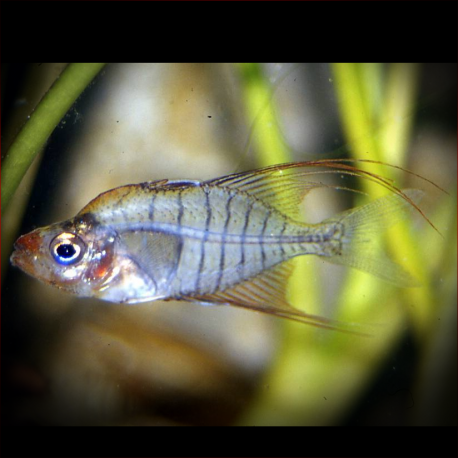More info
Datasheet
| Minimum Tank Size | 60 litres / 15.85 US gallons |
| Maximum Size | 3.2cm / 1.26inches |
| Temperature | 20°C / 68.00°F - 28°C / 82.40°F |
| Hardness | 1.01dgH / 18ppm - 5.04dgH / 90ppm |
| pH | 4.0-6.0 |
General Description
Gymnochanda filamentosa, a species in the order Perciformes and family Ambassidae, is delicate and recommended for experienced aquarists. It can be distinguished by male characteristics like filamentous rays in dorsal and anal fins, transparent yellowish-brown body color in life, and variations in fin shape. The genus Gymnochanda comprises small ambassids with scale-less, translucent bodies and specific fin modifications in mature males.
Aquarium Setup
For optimal care, a densely planted tank with floating vegetation, roots, twigs, and natural leaf litter is recommended. Strong filtration should be avoided, with an air-powered sponge-type unit preferred due to the species' preference for pristine environments. It is essential to maintain water parameters within a pH range of 4.0-6.0, hardness of 18-90 ppm, and a temperature between 20-28°C (see table).
Behaviour
Gymnochanda species are gregarious by nature and thrive in groups of 8-10 specimens. They are best kept in a species-specific setup or alongside similarly sized, peaceful species like Boraras, Sundadanio, or Indostomus. These fish may not be suitable for community tanks due to their specific requirements and social nature.
Feeding and Diet
The common diet of Gymnochanda filamentosa consists of small live foods such as Artemia and Daphnia, especially during acclimatization. While frozen and dried alternatives may be accepted over time, live foods are considered essential for their nutritional needs.
Reproduction & Dimorphism
Details regarding the reproduction of Gymnochanda filamentosa are unrecorded. Adult males exhibit sexual dimorphism, with extended dorsal and anal fin spines forming filaments absent in females.
Habitat and Distribution
Gymnochanda filamentosa is typically found in low-altitude, swampy freshwater habitats with still or slow-moving acidic water, silt, and peat substrates. Its distribution is limited, with confirmed records from Johor state in southern Peninsular Malaysia and the Kapuas river system in West Kalimantan province, Indonesia (Borneo). The exact type locality remains uncertain, with mentions of 'southern Malaya' and 'Singapore' in historical descriptions.

